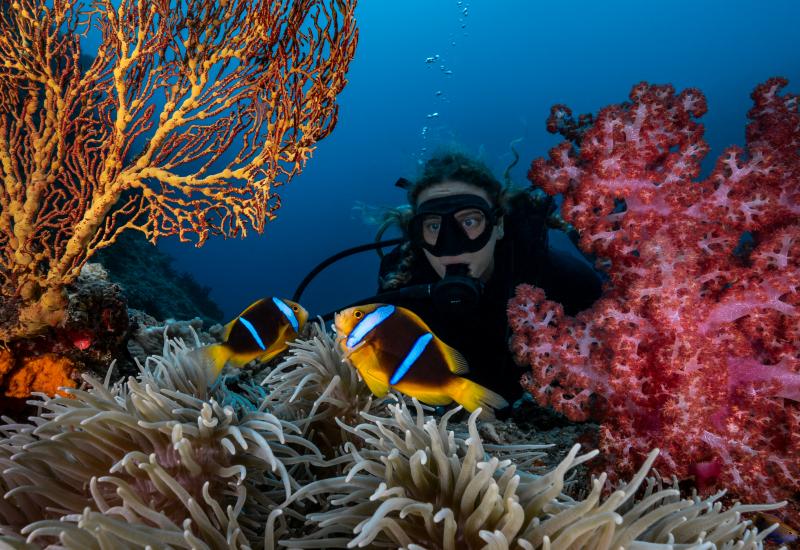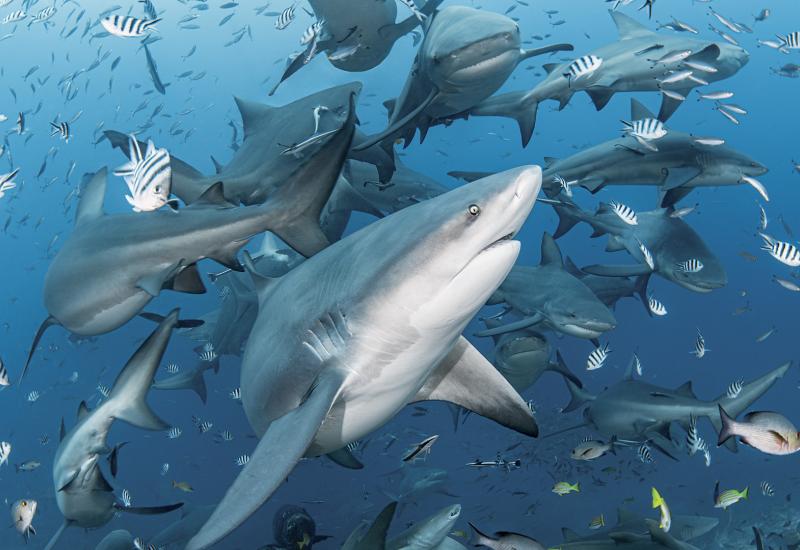Divers Guide to Fiji

Reinhard Dirscherl/Ocean PhotoStunning underwater gardens of anemones and flitting anemonefish await divers on the reefs throughout this welcoming island country.
Good to Know
Language: English, as well as Fijian and Hindi
Currency: Fijian dollar
Signature Dish: Cassava cake is made from the starchy cassava root. It’s dense, thickened with condensed milk.
Signature Topside Activity: Hike to a waterfall! Nearly every island has a few to choose from. One of the most scenic is Tavoro Falls, a series of three waterfalls on the island of Taveuni.
Main Airport: Nadi International Airport, code NAN, on the main island of Viti Levu
Water Temp/Visibility: Water temperatures range from 71-79 degrees, with the cooler temperatures occurring in July. Visibility averages 75 feet and greater.
Travel Tip: Bring extra cash to tip the staff because ATMs are difficult to find in Fiji
Shark dives, barrier islands, mantas and fields of soft coral are all the stuff of a Fijian holiday, making it a longtime favorite of divers. But do your homework. Although all of the 110 inhabited islands (among the 330 in total) each offer the romance, jungles and waterfalls that have made the destination a favorite among honeymooners, not all deliver the world-famous reefs you’re looking for. Choose one known for its scuba diving, and you’ll enjoy an unforgettable experience, with drift diving, pinnacles, shark feeds, wall diving and so much more.
Big Animals
Players Club
Fiji is equally well known for colorful soft-coral reefs as it is for sharks, and the two converge off the island of Beqa, just south of Fiji’s main island. Here, nine species of shark show up at an arena where two dives are held; the first dive is to 100 feet, and the second to 55. All the while, divers watch as incoming tigers, bulls, sicklefin lemons and other species come in to be hand-fed. Post dive, don’t forget to check the sand for any fallen teeth, which you’re welcome to take home as souvenirs.
Flying High
Head to Great Astrolabe Reef, found off the island of Kadavu, for manta encounters — impressive not just for the big numbers that show up but also for how long they last. Local records indicate that as many as 30 show up at a time, staying as long as the mating dance takes. Because this is a site where they mate as well as receive cleanings from wrasses, it’s common to see the famous manta trains, wherein these animals, each with a wingspan of up to 20 feet, fall in line one behind the other as they swing and swoop, carving arcs and loops overtop this barrier reef. Encounters are possible all year long, but the season that offers almost guaranteed daily sightings is May through October.
Deep Wonder
Bligh Water, aka the Vatu-I-Ra Passage, off the island of Vatu, is famous for the pinnacle known as E6. This spectacle rises from 3,280 feet down to within inches of the surface. Out here, schools of gray sharks are an everyday sighting, and hammerheads, schooling trevally and barracuda are often in the mix.
Walls
Color Palette
Anyone who’s dived Fiji won’t be surprised that two of the walls that ranked in the Readers Choice survey are named for colors: Purple Wall and the Great White Wall, both found off the island of Taveuni, northwest of Fiji’s main island of Viti Levu, and across the Somosomo Strait from Vanua Levu. They both belong to the Rainbow Reef — so named for the presence of soft corals in every color imaginable.
Great White Wall is surreal. Sheer and positively covered in white soft corals, it’s a favorite among divers for its unique color, which acts like a giant gallery wall for the anthias and other brightly colored fish life that live here. Plus, it drops to 300 feet, making for a thrilling look down. Note that currents keep the corals healthy, and also dictate when and how often local operators can visit. Some resorts will drop in on this site just four days a month, so keep this in mind when booking.
At Purple Wall, yes, purple dominates. But it’s just one of 390 species of corals thriving here, as well as sea turtles, eels, dogtooth tuna and schooling jacks.
Diversity
Natural Color
Maybe it’s hard to get excited about the number 1,500 — as in the number of fish species found on Fijian reefs — until you realize what that looks like. Every moment of a reef dive looks like New Year’s, with clouds of confetti swirling in every direction. Only, the confetti is fish, namely redfin anthias, blue devil damselfish, purple queens, scissortail sergeant majors and blue-green chromis. There are few places on the planet where you will see so much hot pink and electric blue occurring in nature. The color show is the most mesmerizing in shallow water affected by surge, when the schools of fish sway in unison with each wave.
The diversity also includes five species of clownfish: orangefin anemonefish, yellowtail clownfish, Pacific anemonefish, pink anemonefish and a species found nowhere else, the Fiji barberi clownfish, bright red-orange with a single white stripe, named by Gerry Allen in 2008. Because Fiji’s reefs are packed with life, finding gardens of anemones home to dozens of clownfish is easy at many sites.
Culture
Kava Circles
At home, it’s the bar where the after-work crowd gathers. In Fiji, it’s on mats on the floor when the wooden kava bowl comes out. Inside the bowl, the roots of the kava plant are ground and mixed with water to create a drink that looks like watered-down hot chocolate but has a relaxing, mellowing effect on the mind and body. Drink, and the sensation starts with a numbing of the tongue, and spreads to a warmth throughout the body. But beyond the physical effects, the ceremony is much more about being a part of a local tradition. Singing accompanies the ceremony, and the words are simple enough that anyone can join in, and, like the drinking, everyone is encouraged to take part in raising voices and cups.
Land of Smiles
Maybe it’s because they live under a sky filled with rainbows. Maybe it’s because the scenery is jungles and waterfalls. Whatever the reason is, Fijian people are named the happiest on the planet. For travelers, this means staying at resorts where the staff feels more like family after a week together.
For families, it means not worrying about your kids as they dash off to the kids club and babysitting services. Plus, on the smaller islands, it’s common to be invited into the village where a lot of the resort staff lives. You’ll often be serenaded by school children, who are grateful if you’re able to pack along pencils, notepads or other school supplies.
It all adds up to an intimate, warm experience that will leave you smiling long after you’ve returned home. And it’s also why this beautiful archipelago made the top-five list for best overall dive destination in the Pacific/Indian Ocean/Red Sea region.
2019 Readers Choice Awards
- 5th Place: Best Overall Dive Destination
- Top 10, Best Wall Dives: Great White Wall, Taveuni; Purple Wall, Taveuni; Great Astrolabe Reef, Kadavu
- Top 10, Best Night Dive: Rainbow Reef, Taveuni
- Top 10, Best Cultural Experience: Firewalkers and kava ceremonies, Beqa










